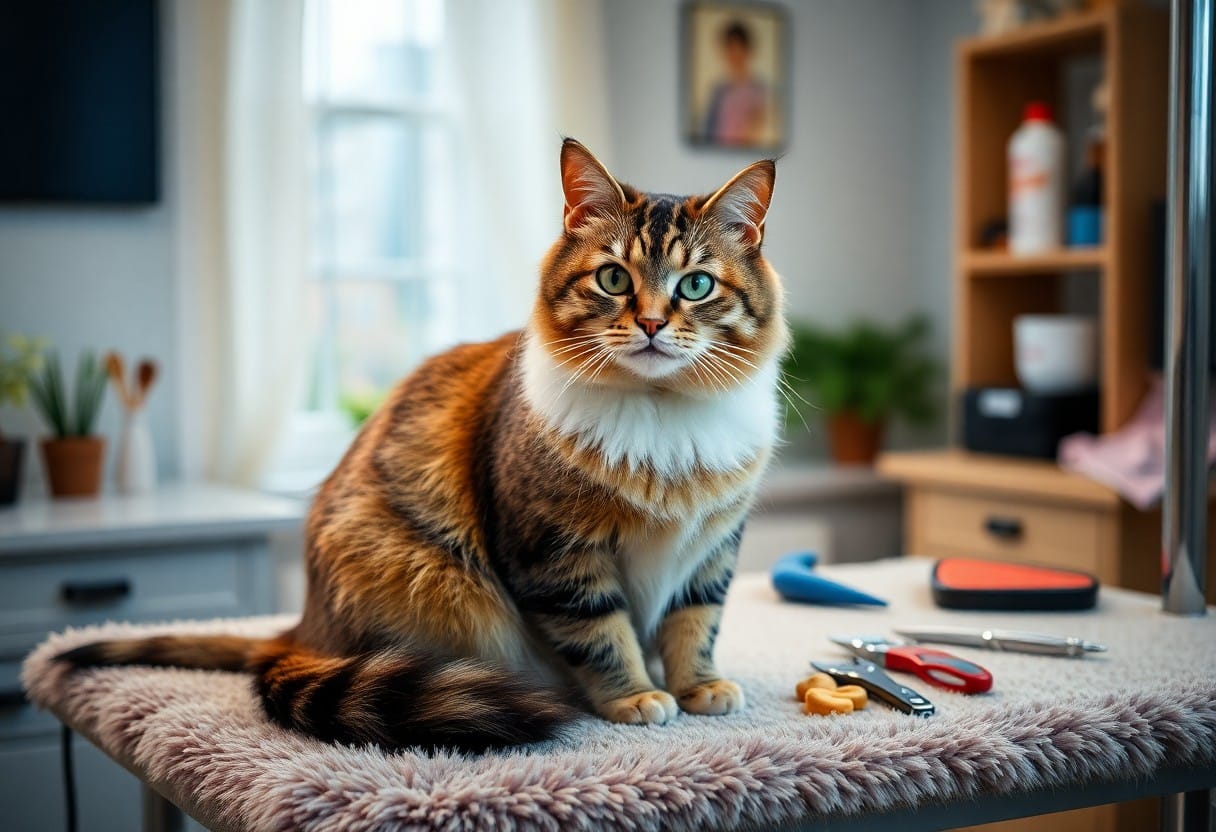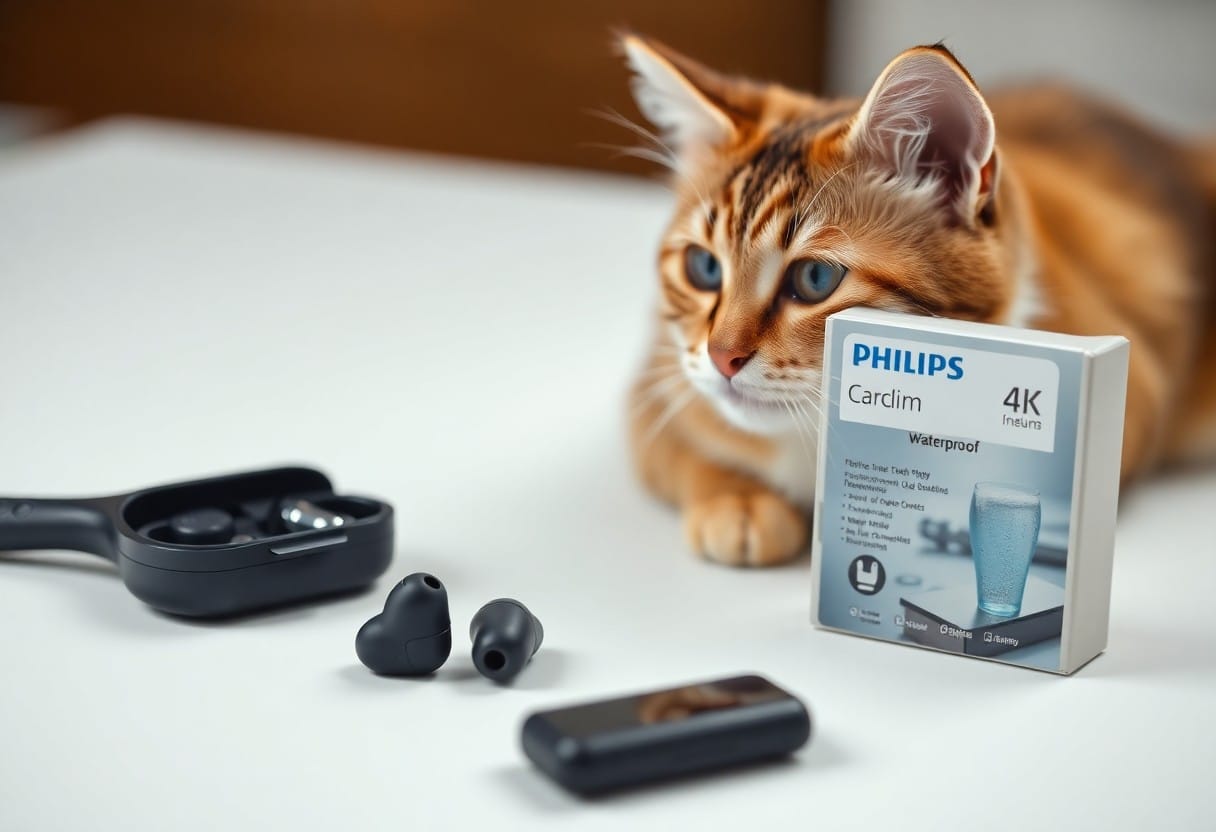This guide will empower you to groom your cat effectively and safely at home, ensuring a positive experience for both you and your furry friend. You’ll learn about imperative grooming tools, step-by-step techniques for brushing, bathing, and nail clipping, as well as how to address common grooming challenges. With a little patience and practice, you can transform grooming time into a bonding experience that keeps your cat looking and feeling their best. Get ready to commence on this rewarding journey with your feline companion!
Key Takeaways:
- Equip yourself with the right tools: Invest in quality grooming supplies such as brushes, combs, nail clippers, and shampoos tailored for cats. This will ensure a smoother grooming process and help maintain your cat’s coat and overall hygiene.
- Make grooming a positive experience: Introduce grooming gradually and associate it with treats or playtime. This approach will help your cat feel more comfortable and reduce stress during grooming sessions.
- Stay attentive to common grooming challenges: Be aware of potential issues like matting, skin irritations, and nail overgrowth. A proactive approach to these problems can prevent discomfort and promote a healthier environment for your cat.
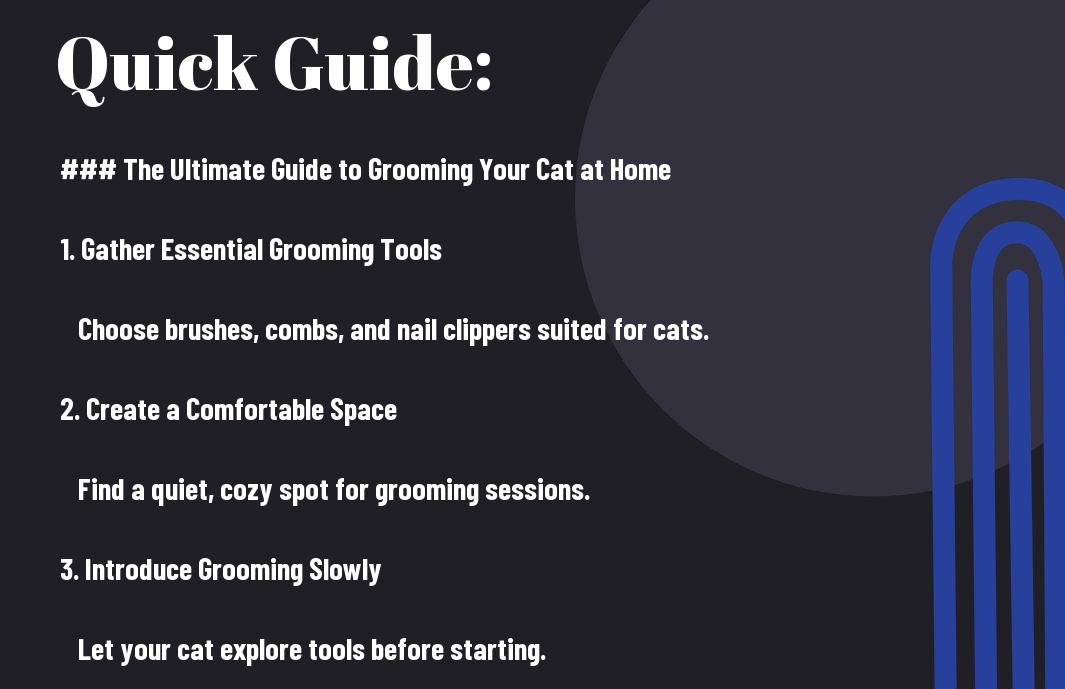
Types of Grooming Tools
While grooming your cat at home, selecting the right tools is important for effective maintenance and your cat’s comfort. Tools can enhance the grooming experience, making it smoother and more enjoyable. Here are some important grooming tools:
| Brushes | For regular fur maintenance |
| Combs | For detangling and removing debris |
| Nail Clippers | For nail trimming tasks |
| Grinders | For a smoother nail finish |
| Wipes | For cleaning sensitive areas |
Perceiving the right tools can significantly impact your grooming process and your cat’s overall experience.
Brushes and Combs
Assuming you have the right brushes and combs on hand, grooming your cat becomes a straightforward task. Brushes come in various types, like slicker brushes for removing loose fur and undercoats, while combs help with detangling and cleaning. Each type serves a unique purpose, aiding in maintaining your pet’s coat in optimal condition.
Nail Clippers and Grinders
If you’re looking to maintain your cat’s nails, a good pair of nail clippers or a grinder is important. These tools help manage your cat’s nails effectively, reducing risk of injury to you and damage to your home. There are two main types of clipper styles: scissor-type and guillotine-type, both designed for straightforward use.
Nail trimming is a vital part of grooming that can keep your cat safe and comfortable. Regular trims help prevent nails from becoming too long, which can lead to painful split nails or injuries. When using nail clippers, be cautious to avoid the quick—the pink area inside the nail that contains nerves and blood vessels. For a less stressful option, consider using a grinder, which provides a smoother finish and reduces the risk of cutting too short. Developing a positive routine can ensure your cat stays calm during this necessary grooming step.
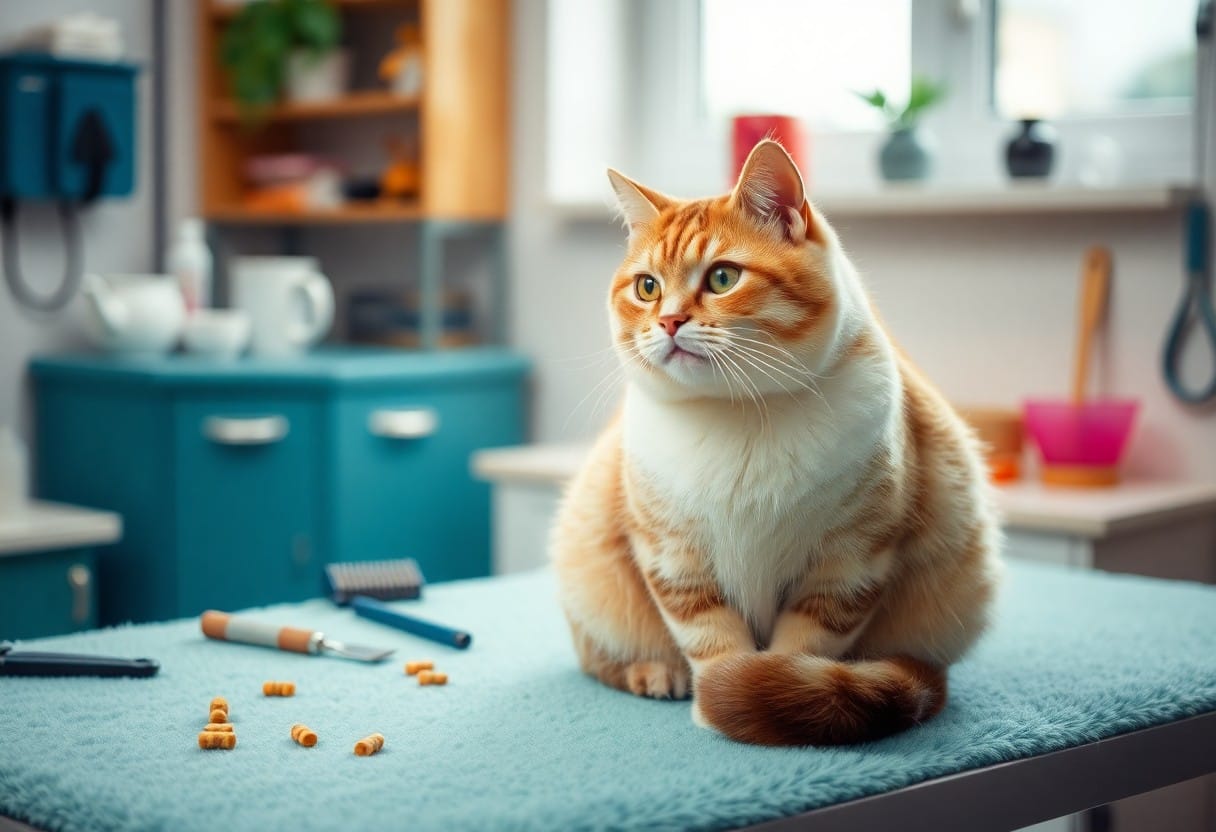
The Step-by-Step Grooming Process
It can be both rewarding and enjoyable to groom your cat at home. Following a structured grooming process helps ensure that you cover all necessary areas while fostering a positive experience for you and your furry friend. Below is a simple guide to follow:
| Step | Description |
| 1. Gather your tools | Collect brushes, nail clippers, and cleaning supplies. |
| 2. Choose a calm environment | Pick a quiet space free from distractions for a soothing experience. |
| 3. Start with brushing | Brush your cat to remove dirt and reduce shedding. |
| 4. Check ears and trim nails | Inspect and clean ears, followed by nail clipping. |
| 5. Finish with rewards | Give treats and affection to reinforce positive behavior. |
Brushing Techniques
If you want to keep your cat’s coat shiny and free of tangles, brushing is imperative. Use a brush suited to your cat’s coat type—whether it’s short, long, or dense—to effectively remove loose hair and prevent matting. Aim for a gentle approach, allowing your cat to become accustomed to the sensation and enjoy the process.
Nail Clipping and Ear Cleaning
Even though nail clipping and ear cleaning might seem daunting, these tasks are vital for your cat’s health. Regular nail trimming prevents painful overgrowth, while cleaning ears can help avoid infections. Approach these tasks slowly and gently to make your cat feel at ease.
With the right techniques, keeping your cat’s nails trimmed and ears clean can become part of a healthy grooming routine. Use high-quality nail clippers designed specifically for cats, ensuring safety and precision during the clipping process. For ear cleaning, opt for a gentle solution recommended by your veterinarian, and avoid inserting anything deep into the ear canal to prevent injury or infection. Always reward your cat afterward with treats and affection, making these grooming activities associated with positive experiences.
Factors to Consider for Effective Grooming
Keep in mind that several factors impact how you groom your cat effectively. Understanding these can streamline the grooming process and enhance your cat’s experience:
- Cat breed and coat type
- Age and health conditions
- Grooming frequency and duration
- Available tools for grooming
Recognizing these key aspects makes it easier to tailor your grooming routine to meet your cat’s unique needs.
Cat Breed and Coat Type
Clearly, different cat breeds have varying grooming requirements based on their coat types. Long-haired breeds like the Maine Coon require more frequent brushing to prevent tangles and matting, while short-haired cats like the British Shorthair may need less frequent grooming. Identifying your cat’s breed and coat type allows you to choose the appropriate tools and techniques, making the process smoother and more enjoyable for both you and your feline friend.
Age and Health Considerations
Effective grooming also depends on your cat’s age and health status. Kittens may require early introductions to grooming routines, while elderly cats may need more gentle handling. Be attentive to any health issues that could affect grooming, such as arthritis or obesity, which might make it difficult for them to maintain their coat independently.
Breed and age create varying scenarios in grooming. For instance, senior cats might be prone to arthritis, making it uncomfortable for them to be brushed for extended periods. Obese cats also struggle with self-grooming. By providing shorter, more frequent grooming sessions, you can ensure that your cat remains comfortable. Additionally, consider using specialized tools designed for sensitive cats to ease the grooming process. Establishing a gentle routine encourages a positive experience while addressing your cat’s unique grooming needs, keeping their coat healthy and shiny.
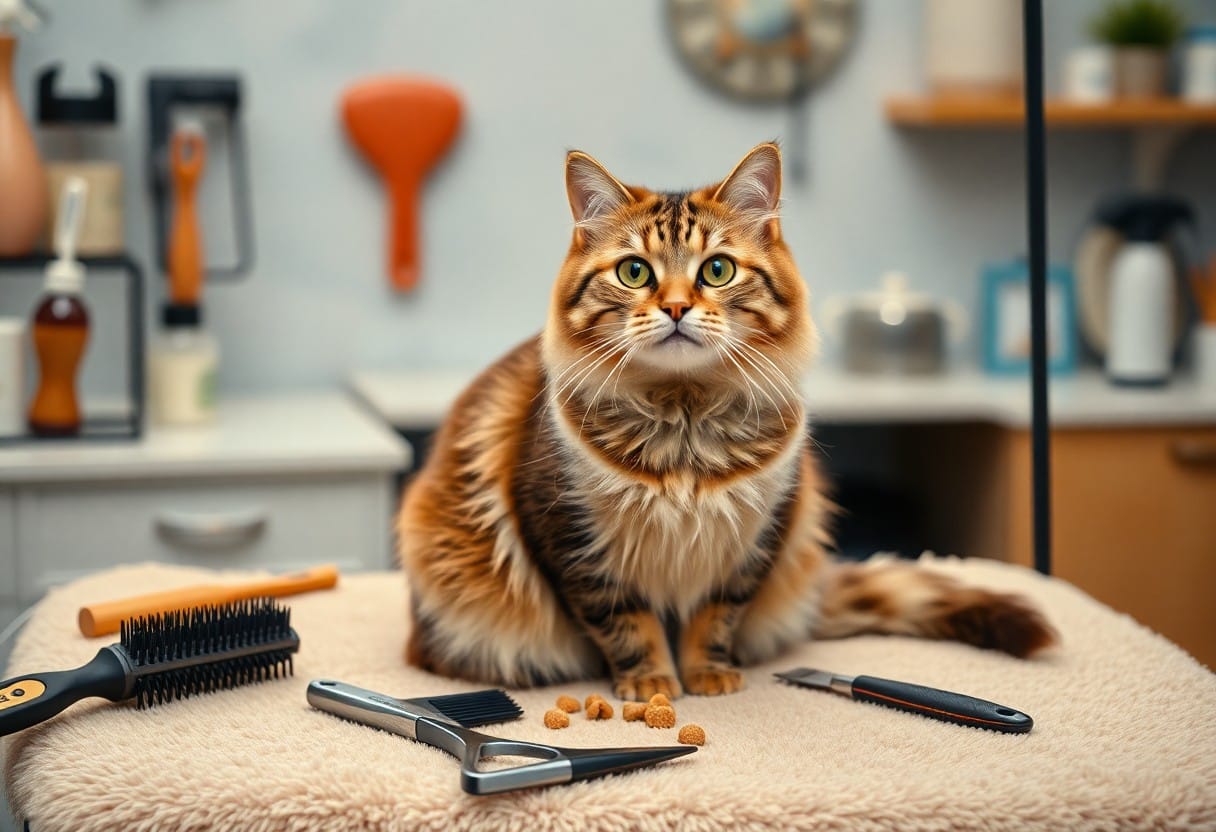
Tips for Successful Grooming
All successful grooming sessions depend on your approach and the tools used. To ensure a positive experience for both you and your cat, consider the following tips:
- Choose the right tools for your cat’s coat type.
- Start grooming on a calm and relaxed day.
- Use positive reinforcement like treats and praise.
- Ensure a comfortable area with minimal distractions.
The key is to be patient and to make grooming an enjoyable routine.
Creating a Positive Experience
On your journey to groom your cat, creating a positive experience is vital. Use soft brushes that feel good on your cat’s skin, and allow them to explore the grooming tools before starting. Keep the sessions short initially and offer treats as rewards during and after the grooming. This helps build a joyful association with the process, allowing your cat to relax and enjoy their grooming time with you.
Frequency and Timing of Grooming
Positive grooming habits will improve your cat’s coat and health. How often you groom your cat depends on their coat type. Long-haired cats may need daily grooming to avoid tangles and mats, while short-haired breeds can be groomed weekly. Choose a consistent time for grooming, when your cat is naturally relaxed, like after a meal or a play session, to create a soothing routine for both of you.
Creating a structured grooming schedule is key for maintaining your cat’s hygiene and comfort. A routine not only helps in controlling shedding but also reduces the likelihood of skin issues or hairballs, particularly in long-haired breeds. Be aware that frequent grooming helps you spot any potential problems early on, including fleas or skin irritations, ensuring that your cat stays happy and healthy.
Pros and Cons of Grooming at Home
Despite the benefits, grooming your cat at home comes with its own set of advantages and challenges. Understanding these pros and cons can help you make an informed decision that benefits both you and your feline friend.
Pros and Cons of Grooming at Home
| Pros | Cons |
|---|---|
| Cost-effective | Time-consuming |
| Bonding experience | Potential stress for the cat |
| Control over grooming routine | Risk of injury without proper technique |
| Convenience | Need for training |
| Customizable grooming | Limited access to specialized tools |
Benefits of DIY Grooming
An effective home grooming routine benefits you by creating a stronger bond with your cat while also saving money on professional services. You gain control over the grooming schedule, allowing for more frequent maintenance that can help prevent matting and health issues. This personalized approach also enables you to observe your cat closely, which can lead to early detection of potential health concerns.
Potential Challenges
You may encounter several challenges when grooming your cat at home, including difficulty in handling a restless or anxious pet. Some cats may not tolerate grooming well, leading to frustration for both of you. Moreover, without proper training and tools, you risk injuring your cat while trying to trim nails or tackle matted fur.
Challenges such as managing your cat’s discomfort and fear during grooming can be daunting. It’s significant to approach each session with patience and a calm demeanor, ensuring a positive experience. If your cat shows signs of extreme stress or aggression, consider consulting with a professional groomer or veterinarian. Proper technique is especially important for tasks like nail clipping, where slipping can lead to injury. Investing in the right tools and familiarizing yourself with your cat’s body language can make a world of difference in transforming grooming from a chore into a bonding activity.
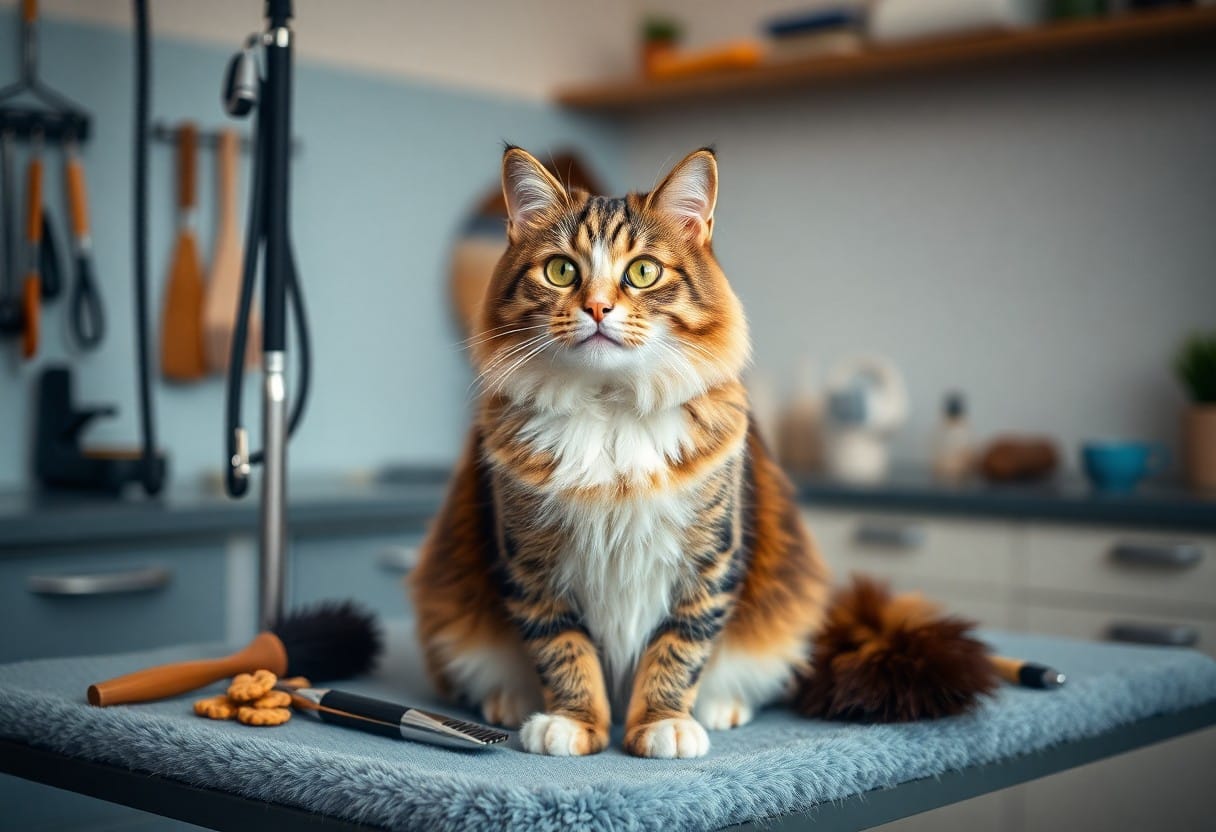
Troubleshooting Common Grooming Issues
For many cat owners, grooming can come with its fair share of challenges. You might encounter issues such as anxiety, mats, or tangles that can make grooming feel daunting. Understanding how to effectively troubleshoot these common grooming problems will help ensure a smoother experience for both you and your cat, making it a positive bonding time.
Dealing with Anxiety
An anxious cat might resist grooming, causing stress for both you and your feline friend. To alleviate this, start by creating a calm environment. Use soft voices and gentle touches, and provide a cozy spot where your cat feels safe. Gradually introduce the grooming tools, allowing your cat to sniff them before starting, which helps build trust and familiarity.
Managing Mats and Tangles
While dealing with mats and tangles can be frustrating, addressing them promptly is crucial to keep your cat’s coat healthy. Use a combination of a slicker brush and a wide-toothed comb to gently work through any mats. Always start from the ends and work your way up to minimize pulling and discomfort. If a mat is particularly tight, consider using a mat splitter or seeking professional help to avoid skin injuries.
This approach ensures you tackle mats safely and effectively. Always keep your cat’s skin health in mind, as pulling too hard can cause pain or injury. If you find yourself repeatedly battling mats, consider incorporating regular grooming sessions into your routine to prevent tangles from forming in the first place. By making grooming a regular part of your cat’s care, you not only keep their coat looking great but also create an opportunity for positive engagement between you and your pet.
Final Words
On the whole, grooming your cat at home is not only a practical skill but also an opportunity to bond with your furry friend. By following this comprehensive guide, you can equip yourself with the right tools and techniques to make grooming a stress-free experience for both you and your cat. Whether it’s brushing, bathing, or nail clipping, a little patience and practice will go a long way in maintaining your pet’s health and happiness. Enjoy the grooming journey, and watch your cat flourish with your attentive care!
FAQ
Q: What crucial tools do I need for grooming my cat at home?
A: To groom your cat effectively at home, you’ll need a few key tools. Firstly, a good quality grooming brush is necessary; a slicker brush works wonders for long-haired breeds, while a bristle brush is great for short-haired cats. Additionally, a comb helps to detangle any mats in the fur. Nail clippers designed specifically for cats, or a nail grinding tool, are important for safe nail trimming. Don’t forget to get some cat-safe shampoo for occasional baths, and a soft towel for drying. Having treats on hand can also help make the process more enjoyable for your cat!
Q: How can I make grooming a positive experience for my cat?
A: Making grooming enjoyable for your cat can be achieved with patience and positive reinforcement. Start by getting your cat comfortable with being touched and handled; this can be done through gentle petting. Choose a calm and quiet space for grooming, and introduce the grooming tools gradually. Be sure to offer treats and praise whenever your cat allows you to brush or clip their nails. If your cat shows signs of stress, take breaks and try again later. Over time, your cat will learn to associate grooming with positive rewards!
Q: What are some common issues that may arise during grooming, and how can I address them?
A: One common issue is matting, particularly in long-haired breeds. To address this, regularly brush your cat to prevent mats from forming. If mats do occur, you can carefully use a detangling spray and a comb to gently tease them apart. Another concern is nail clipping, as some cats may resist. If that’s the case, take it slow; start by just handling their paws and rewarding them, then gradually introduce the clippers. Lastly, some cats may be sensitive about certain areas being groomed, so pay attention to their body language and adjust your approach accordingly.
—
The Ultimate Guide to Grooming Your Cat at Home
Grooming your cat at home can enhance their well-being and strengthen the bond you share. Not only does it keep their coat healthy and free from debris, but it also allows you to check for any skin issues or parasites. This guide will walk you through everything from crucial tools to practical steps and how to tackle common grooming challenges.
Essential Tools for Grooming
- Grooming Brush: Choose a brush based on your cat’s coat type—slicker brushes for long hair and bristle brushes for short hair.
- Comb: A fine-toothed comb is great for detangling and getting rid of loose hairs.
- Nail Clippers: Look for cat-specific nail clippers or grinders for safe trimming.
- Cat-safe Shampoo: Opt for gentle formulas meant for feline skin.
- Soft Towel: Useful for drying after baths or cleaning up any messes.
- Treats: Keep some tasty rewards handy to create a positive association with grooming.
Step-by-Step Grooming Tips
The grooming process can vary depending on your cat’s coat and temperament. Here’s a simple step-by-step guide:
- Brushing: Start with dry fur; brush gently in the direction of their coat. For long-haired cats, divide the coat into sections for thorough grooming.
- Nail Clipping: Hold your cat securely but gently, and press on the pad of each paw to extend the nails. Clip only the tip of each nail to avoid cutting into the quick.
- Bathing (if necessary): If your cat needs a bath, use warm water and a cat-safe shampoo, lathering gently and avoiding the face. Rinse thoroughly and dry with a towel.
- Inspection: During grooming sessions, take the opportunity to check your cat for any lumps, bumps, or signs of parasites.
Common Issues and Solutions
- Matting: Use a detangling spray and a comb for mats. For severe matting, consider consulting a professional groomer.
- Resisting Grooming: If your cat is anxious, approach gradually, using treats to encourage good behavior. Short, frequent grooming sessions can be effective.
- Skin Sensitivity: If your cat shows discomfort, avoid certain areas and focus on their more relaxed zones, like their back or sides.
Keeping your cat well-groomed is part of responsible pet ownership. With these tips and tools, you can create a positive grooming experience—one that both you and your feline friend can enjoy. Happy grooming!
